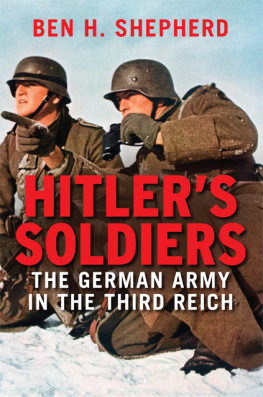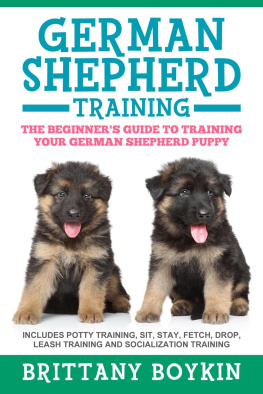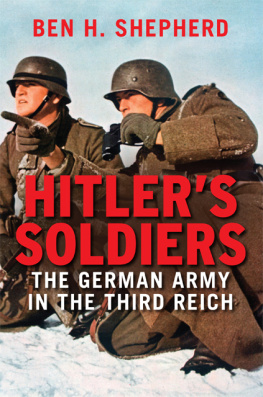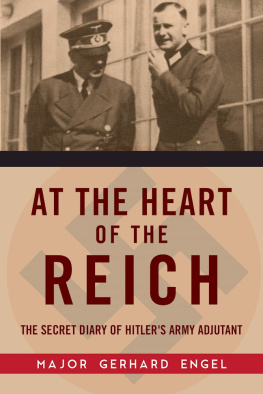Ben H. Shepherd - Hitlers Soldiers: The German Army in the Third Reich
Here you can read online Ben H. Shepherd - Hitlers Soldiers: The German Army in the Third Reich full text of the book (entire story) in english for free. Download pdf and epub, get meaning, cover and reviews about this ebook. publisher: Yale University Press, genre: Politics. Description of the work, (preface) as well as reviews are available. Best literature library LitArk.com created for fans of good reading and offers a wide selection of genres:
Romance novel
Science fiction
Adventure
Detective
Science
History
Home and family
Prose
Art
Politics
Computer
Non-fiction
Religion
Business
Children
Humor
Choose a favorite category and find really read worthwhile books. Enjoy immersion in the world of imagination, feel the emotions of the characters or learn something new for yourself, make an fascinating discovery.
- Book:Hitlers Soldiers: The German Army in the Third Reich
- Author:
- Publisher:Yale University Press
- Genre:
- Rating:4 / 5
- Favourites:Add to favourites
- Your mark:
- 80
- 1
- 2
- 3
- 4
- 5
Hitlers Soldiers: The German Army in the Third Reich: summary, description and annotation
We offer to read an annotation, description, summary or preface (depends on what the author of the book "Hitlers Soldiers: The German Army in the Third Reich" wrote himself). If you haven't found the necessary information about the book — write in the comments, we will try to find it.
Hitlers Soldiers: The German Army in the Third Reich — read online for free the complete book (whole text) full work
Below is the text of the book, divided by pages. System saving the place of the last page read, allows you to conveniently read the book "Hitlers Soldiers: The German Army in the Third Reich" online for free, without having to search again every time where you left off. Put a bookmark, and you can go to the page where you finished reading at any time.
Font size:
Interval:
Bookmark:


Copyright 2016 Ben H. Shepherd
All rights reserved. This book may not be reproduced in whole or in part, in any form (beyond that copying permitted by Sections 107 and 108 of the U.S. Copyright Law and except by reviewers for the public press) without written permission from the publishers.
For information about this and other Yale University Press publications, please contact:
U.S. Office:
Europe Office:
Typeset in Minion Pro by IDSUK (DataConnection) Ltd
Printed in Great Britain by Gomer Press, Llandysul, Ceredigion, Wales
Library of Congress Cataloging-in-Publication Data
Names: Shepherd, Ben (Ben H.)
Title: Hitlers soldiers : the German army in the Third Reich / Ben H. Shepherd.
Description: New Haven : Yale University Press, 2016. | Includes bibliographical references.
LCCN 2016003731 | ISBN 9780300179033 (cloth : alkaline paper)
LCSH: Germany. HeerHistoryWorld War, 19391945. | SoldiersGermanyHistory20th century. | Germany. HeerMilitary lifeHistory20th century. | World War, 19391945Germany. | Command of troopsHistory20th century. | World War, 19391945Campaigns. | World War, 19391945Occupied territories. | World War, 19391945Atrocities. | War crimesGermanyHistory20th century. | BISAC: HISTORY / Military / World War II. | HISTORY / Europe / Germany. | HISTORY / Military / Strategy.
Classification: LCC D757.1 .S54 2016 | DDC 940.54/1343dc23
LC record available at http://lccn.loc.gov/2016003731
A catalogue record for this book is available from the British Library.
10987654321
CONTENTS
PREFACE
Structure
T HIS BOOK TELLS the story of the German army under the Third Reich. It examines the armys military performance, its relationship with the Nazi regime, its role in military occupation, and its culpability in war crimes. The end of the Cold War saw the release of a vast range of primary sources. This more comprehensive base of information, now made available to western historians, enabled better informed debate in this area, creating an outpouring of new scholarly literature on many aspects of the second World War. The present book is the first general history of the German army under the Third Reich to draw upon this new literature and the new perspectives it provides.
The book takes a narrative approach to its subject. The first two chapters deal with the period 1933 to 1939. These chapters primarily consider the context of, and build-up to, the main period on which the book focuses, that of the Second World War itself, during which all four of the books concerns play central roles.
Literature and sources
In keeping with its broad-based approach, the book draws primarily upon English-language and German-language secondary literature. For illustrative purposes, it also draws upon select primary sources: official German army documents, drawn from the Bundesarchiv-Militrarchiv (BA-MA) in Freiburg-im-Breisgau; excerpts from soldiers letters (Feldpostbriefe) from the Bibliothek fr Zeitgeschichte (BFZ), excerpts of both from various published collections, and various former officers memoirs. The selection of official documents consists largely of i) material produced by the German high command, and by larger field formations, concerned with the troops ideological and national-political instruction, and ii) material produced by a selection of German army divisions, together with the corps and army-level commands to which they were subordinate, covering issues such as combat, logistics, and the determinants of troop morale. Divisions were selected on the basis of the comprehensiveness of archival material pertaining to them, be they official sources or Feldpostbriefe.
The divisions were also selected with a view to assembling a small representative sample of different types of army division. Hence a small number of divisions frequently appear at various points in the text. The division that combines the most extensive sample of Feldpostbriefe with extensive official material is the 12th Panzer Division. Most of the letter excerpts that the book utilises are drawn from the Sterz collection at the BfZ. The main reason for this was accessibility, for an extensive series of excerpts from the letters has been selected, type up and listed by division, all for the benefit of researchers. Excerpts from the Schnepf collection, which the BfZ acquired only recently, have also been used. This is the first book to utilise material from this particular collection.
Use of terms
The book refers to the German army as the German army and not as the Wehrmacht. Whilst many works emply the term Wehrmacht to denote the German army, this is actually incorrect. Wehrmacht directly translates as Armed Forces, and technically speaking the Wehrmacht comprised not just the army, but also the air force (Luftwaffe), navy (Kriegsmarine), and, from 1944, the Waffen-SS. The term Wehrmacht is thus used to denote Armed Forces throughout the book. Other branches of the Armed Forces do receive attention throughout the book, however. This is particularly the case with the Waffen-SS, which fought and operated alongside the army but also rivalled it for resources; and also with the Luftwaffe. The Luftwaffe features in the story in three respects. Like the Waffen-SS, it was both a fellow armed service for the army but also a rival for manpower and resources. In addition, high-ranking Luftwaffe officers frequently acted as commanders of ground forces at army group level and above. In this capacity, they commanded large numbers of army troops.
Online resources
Every effort has been made to provide fully accurate information throughout the text and endnotes. Where any remaining updates are made following the book going to press, these are listed in an online document accessible via the following link: http://www.gcu.ac.uk/gsbs/staff/drbenshepherd/. This link also provides access to scanned examples of primary sources used in this study, for the benefit of readers interested in investigating such sources further.
INTRODUCTION
S EVENTY YEARS AFTER its collapse in 1945, the Third Reich remains a potent source of public and media fascination. Images of the Nazis annual rallies at Nuremberg can still impress and horrify. The spectacle of Nazi troops and weaponry, orchestrated in vast torch-lit arenas, seems to capture the essence of Fascism: mindless obedience, servility and military power. These same images, images that were designed to energize the German people and frighten Nazisms opponents at home and abroad, were staple ingredients of newspapers and newsreels around the world during the 1930s. For foreign observers, to experience this display and to then see and hear the subsequent news reports as Germany overran its weaker neighbours during the late 1930s and early 1940s was to imbibe a terrifying impression of a country with an unstoppable war machine and an insatiable desire for expansion. The fear, for European peoples especially, was: When will they turn on us? Images designed to inspire the susceptible and terrify opponents even now have the power to chill and, for many people, prompt the question: How could they lose?
It was the German Wehrmacht, or armed forces, that achieved the Third Reichs spectacular military conquests. And above all other branches of the Wehrmacht the air force (Luftwaffe), the navy (Kriegsmarine) and, later, the militarized formations of the Waffen-SS it was the German army that made the largest contribution. The German army, then, was the main sword arm of the Third Reich, of its national leader, Adolf Hitler, and of the ideology they espoused. Erwin Rommel, the most famous German general of the Second World War in Western eyes, affirmed this truth when he wrote in December 1938 that the army of the Wehrmacht is the sword of the new German worldview.
Next pageFont size:
Interval:
Bookmark:
Similar books «Hitlers Soldiers: The German Army in the Third Reich»
Look at similar books to Hitlers Soldiers: The German Army in the Third Reich. We have selected literature similar in name and meaning in the hope of providing readers with more options to find new, interesting, not yet read works.
Discussion, reviews of the book Hitlers Soldiers: The German Army in the Third Reich and just readers' own opinions. Leave your comments, write what you think about the work, its meaning or the main characters. Specify what exactly you liked and what you didn't like, and why you think so.









